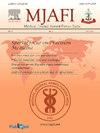谐波噪声比作为疲劳语音生物标记:k近邻机器学习算法
Q2 Medicine
引用次数: 0
摘要
一个人的身体和情绪健康的重要信息可以从他们的声音中感知到。睡眠不足后,人们会注意到声音质量的变化。昼夜节律控制着睡眠周期,当它不正常时,就会导致疲劳,这在说话时就会表现出来。利用MATLAB统计技术和k近邻(KNN)机器学习算法,本研究评估了谐波噪声比(HNR)作为一种语音生物标志物在睡眠剥夺一晚后区分疲劳和正常声音的有效性。方法对32名20 ~ 40岁的印度健康年轻男性志愿者进行1晚的睡眠剥夺后,记录其持续元音/a/和视觉反应时间的声学样本。单因素方差分析证实,进行性睡眠剥夺患者的声音特征发生了显著变化。利用机器学习算法中的KNN分类器,研究了语音HNR作为检测健康和疲劳语音的生物标志物的有效性。结果从声学样本中提取HNR语音特征三次:基线(时间1),凌晨3点(时间2)和早上7点(时间3),以增加一晚睡眠损失。3AM时,HNR变化显著(p < 0.05)。利用迭代信号外推方法,KNN分类器将提交的语音信号样本分为正常和疲劳两类。研究结果表明,HNR可以通过KNN分类器对声音样本进行分类,将睡眠剥夺引起的疲劳与声音变化联系起来。除了多模态诊断特征外,该方法还可以为诊断睡眠不足后的疲劳提供额外的声学生物标志物。本文章由计算机程序翻译,如有差异,请以英文原文为准。
Harmonic-to-noise ratio as speech biomarker for fatigue: K-nearest neighbour machine learning algorithm
Background
Vital information about a person's physical and emotional health can be perceived in their voice. After sleep loss, altered voice quality is noticed. The circadian rhythm controls the sleep cycle, and when it is askew, it results in fatigue, which is manifested in speech. Using MATLAB statistical techniques and the k-nearest neighbour (KNN) machine learning algorithm, this study assessed the efficacy of the harmonic-to-noise ratio (HNR) as a speech biomarker in differentiating fatigued and normal voice after sleep deprivation of one night.
Methods
After one night of sleep deprivation, acoustic samples for sustained vowel/a/and visual reaction time were recorded from n = 32 healthy young Indian male volunteers (20–40 yrs). One-way ANOVA established significant changes in voice characteristics with progressive sleep deprivation. The effectiveness of speech HNR as a biomarker for the detection of healthy and fatigued voice was researched, using the KNN classifier in a machine learning algorithm.
Results
The HNR voice feature was taken from an acoustic sample for three times: baseline (Time 1), 3 AM (Time 2), and 7 AM (Time 3) towards an incremental one-night sleep loss. At 3AM, the HNR changed significantly p<0.05. Utilizing an iterative signal extrapolation approach, the KNN classifier divided the submitted voice signal sample into normal and fatigued categories.
Conclusion
The findings imply that the HNR can be used to link fatigue from sleep deprivation with vocal alterations by classifying voice samples in a KNN classifier. Along with the multimodal diagnostic features, this method may also offer an additional acoustic biomarker for the diagnosis of fatigue post sleep loss.
求助全文
通过发布文献求助,成功后即可免费获取论文全文。
去求助
来源期刊

Medical Journal Armed Forces India
Medicine-Medicine (all)
CiteScore
3.40
自引率
0.00%
发文量
206
期刊介绍:
This journal was conceived in 1945 as the Journal of Indian Army Medical Corps. Col DR Thapar was the first Editor who published it on behalf of Lt. Gen Gordon Wilson, the then Director of Medical Services in India. Over the years the journal has achieved various milestones. Presently it is published in Vancouver style, printed on offset, and has a distribution exceeding 5000 per issue. It is published in January, April, July and October each year.
 求助内容:
求助内容: 应助结果提醒方式:
应助结果提醒方式:


